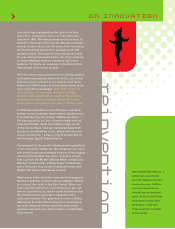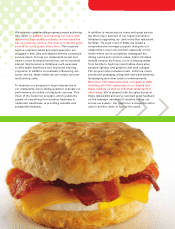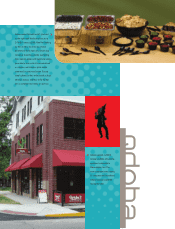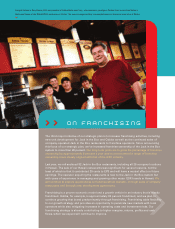Jack In The Box 2006 Annual Report Download - page 18
Download and view the complete annual report
Please find page 18 of the 2006 Jack In The Box annual report below. You can navigate through the pages in the report by either clicking on the pages listed below, or by using the keyword search tool below to find specific information within the annual report.
2
PART I
ITEM 1. BUSINESS
The Company
Overview. Jack in the Box Inc. (the “Company”) owns, operates and franchises JACK IN THE BOX® quick-service
hamburger restaurants and Qdoba Mexican Grill® (“Qdoba”) fast-casual restaurants. In fiscal 2006, we generated
total revenues of $2.8 billion. As of the end of our fiscal year on October 1, 2006, the JACK IN THE BOX system
included 2,079 restaurants, of which 1,475 were company-operated and 604 were franchise-operated. JACK IN THE
BOX restaurants are located primarily in the western and southern United States. Based on the number of units,
JACK IN THE BOX is the second or third largest quick-service hamburger chain in most of its major markets. As of
October 1, 2006, the Qdoba Mexican Grill system included 318 fast-casual restaurants in 40 states, of which 70 were
company-operated and 248 were franchise-operated.
Background. The first JACK IN THE BOX restaurant, which offered only drive-thru service, opened in 1951. By
1968, the JACK IN THE BOX chain had expanded its operations to approximately 300 restaurants. After the Company
was purchased in 1968 by Ralston Purina Company, a major expansion program was initiated in an effort to
penetrate the eastern and midwestern markets, and by 1979 the business had grown to over 1,000 units. In 1979, the
Company decided to divest 232 restaurants in the east and midwest to concentrate its efforts and resources in the
western and southwestern markets, which were believed to offer the greatest growth and profit potential at that time.
In 1985, a group of private investors acquired the Company and, in 1987, a public offering of common stock was
completed. In 1988, the outstanding publicly-held shares were acquired by private investors through a tender offer.
In 1992, a recapitalization was completed that included a public offering of common stock and indebtedness. Since
that time, we have continued to grow, primarily through the addition of new company-operated restaurants, and we
entered new markets in the Southeast beginning in 1999. In addition, to supplement our core growth and balance the
risk associated with growing solely in the highly competitive hamburger segment of the quick-service restaurant
(“QSR”) industry, on January 21, 2003, we acquired Qdoba Restaurant Corporation, operator and franchisor of
Qdoba Mexican Grill, expanding our growth opportunities into the fast-casual restaurant segment.
Strategic Plan. We plan to grow to a national restaurant company by focusing on three key strategic initiatives:
(1) reinventing the JACK IN THE BOX brand, (2) profitably growing the business, and (3) expanding franchising
activities. We are taking a holistic approach to reinventing the JACK IN THE BOX brand by upgrading our menu, guest
service and restaurant facilities. Our multifaceted growth strategy includes increasing same-store sales at JACK IN
THE BOX and Qdoba, and new unit growth for both of these restaurant concepts. Our third strategic initiative to
expand franchising activities includes new unit development for both restaurant concepts as well as continued
refranchising of company-operated JACK IN THE BOX restaurants.
Strategic Plan – Brand Reinvention.We believe that brand reinvention will differentiate us from our
competition and make JACK IN THE BOX a preferred brand by offering our guests a better restaurant experience than
typically found in the QSR segment. Our JBX Grill test, which was cancelled in fiscal 2005, has been a catalyst for
developing innovative new menu items, service initiatives and creative restaurant design elements for use across the
more than 2,000 existing restaurants comprising our core JACK IN THE BOX brand. Brand reinvention will include the
following changes to the restaurant experience:
•Menu Innovation. We believe that menu innovation and our focus on higher-quality products will further
differentiate JACK IN THE BOX from competitors, strengthen our brand and attract a broader consumer
audience. In support of this initiative, in fiscal 2006 JACK IN THE BOX enhanced its menu in the following
ways: expanded our line of burgers and sandwiches served on artisan, hearth-baked ciabatta bread to include
the Chipotle Chicken Ciabatta and Breakfast Ciabatta sandwiches; introduced buttermilk biscuits with two
sandwiches – a Bacon, Egg & Cheese and Sausage, Egg & Cheese; and enhanced our real ice cream shakes,
including new flavors like Vanilla Malted Crunch and Orange & Cream, by adding a retro-style swirl of
creamy whipped topping and a cherry. We also leveraged partnerships with several major brand-name vendors
and added the following: a fresh fruit cup from Del Monte; Minute Maid orange juice, Dannon bottled water,
and a Chocolate Chip Cookie Cheesecake made with Nestle Toll House semi-sweet morsels. Additional
premium-quality products are in various stages of test and development as we continue to innovate and
enhance product quality as a means to differentiate our menu from other quick-service chains.
























